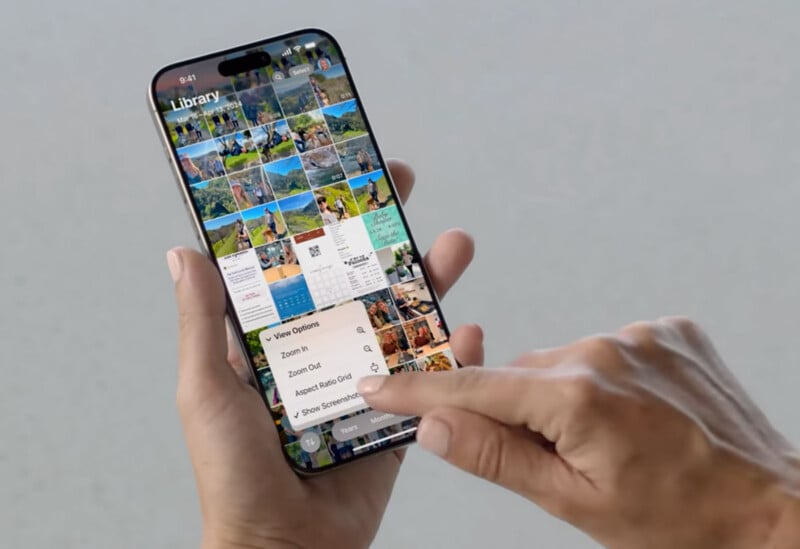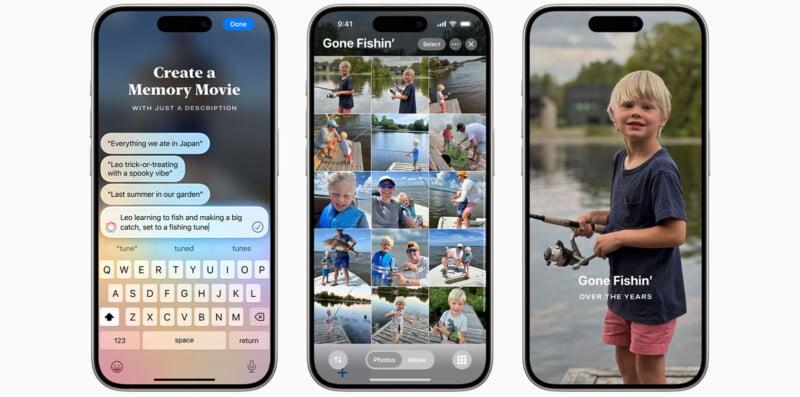![]()
At Apple’s annual WWDC event in early June, the company announced that a redesigned Photos app was on the way, complete with AI-powered photo editing thanks to Apple’s ambitious new Apple Intelligence platform. PetaPixel spoke to three of the many people behind the all-new Photos app to learn more about the team’s goals and how the new app will transform the user experience.
While apps like Lightroom and Photoshop may occupy more space in the minds of seasoned photographers, Photos on iOS and iPadOS is one of the most-used apps in the world, and the primary way that hundreds of millions of people interact with their most important and personal photos and videos.
The Organizational Demands of Smartphone Photographers
“Over three trillion photos and videos a year are shot on iPhone, which is a number that just astounds me,” explains Della Huff, Apple product manager.
That’s a staggering number of photos; organizing them is no easy feat.
As iPhone camera technology continues to improve, the velocity with which people amass files has increased, leading to a problem nearly every photographer is all too familiar with, having too many photos.
![]()
“Obviously people are taking really important memories with their cameras, with their photos of their families, their friends, their celebrations, their pets, their hobbies, all of those really salient and personal memories,” Huff explains. “But as you know, the iPhone camera does a lot more than take amazing photos of family and friends.”
Photos of receipts, helpful reminders about where the car is parked, screenshots, and memes people send in Messages end up in Photos, too, creating clutter and making it more difficult to find the photos that people care about most.
This is a crucial area of focus for the Photos team, as the redesigned app features intelligent new collections, powerful organizational tools, and sophisticated filtering to keep the most essential content front and center. All the other stuff is still there, able to be retrieved at will, but gone are the days of having to scroll through screenshots and receipts to find a favorite photo from a recent vacation.
“It’s hard to find what you’re looking for in the [current] Photos app because you simply just have so much stuff going on,” Huff adds.
When Redesigning an App so Many People Use, Every Detail Matters
Solving this problem requires many steps. While Huff explained the “why” behind the Apple Photos redesign, Billy Sorrentino from Apple’s Design Team explained the user experience.
When redesigning an app that so many people use daily, no detail is too small to consider — and consider again.
“The Photos app has such a rich history to the early stages of iPhone with established features that users love and use every single day,” Sorrentino acknowledges. “So, most importantly, it was critical to us that we didn’t lose any key features that people use and love today.”
![]()
Over the past nearly two decades, Apple has changed and tweaked Photos, adding new feature after new feature, which has increased the density and complexity of the app’s user interface and overall experience. As Sorrentino admits, this has resulted in some users needing to hunt for what they’re looking for, which is not ideal, especially for an app that houses a person’s most precious memories.
The New Apple Photos is Streamlined and Powerful
“Throughout the app, we decided to create a simple, streamlined, single view Photos experience, all based around deep intelligence,” Sorrentino explains. “Ultimately, we want to remove friction and help users find the photos they want and play them back in a beautiful and cinematic way.”
When users install iOS 18 later this year and open the redesigned Photos app for the first time, they will first see a streamlined image library, which can be sorted by date captured or recently added. Gone is the “recent” album prominently featured in the current Photos app. And yes, users can still navigate by year, month, or even specific date, but the star of the show is a unified scrolling library.
This new library grid comes with advanced filtering options, accessible in the bottom left corner of the user interface. A common use case for filtering is removing screenshots from the library view or showing only “favorite” photos.

So far, the unified library, while able to reduce clutter, doesn’t address the issue of having too many photos to sort through. That’s where sophisticated new organizational and presentation features come in.
“We’ve used deep intelligence to organize your content into meaningful themes,” Sorrentino explains. “We’re calling these ‘collections.’ Collections pull together pinned collections at the top for recent days, your nearest and dearest people and pets, trips, memories, utilities, and of course, your favorite albums and shared albums.”
The idea behind collections is to provide a media-rich, visuals-first experience that organizes a user’s best and most important photos and videos based on a rich set of analyzed data and behaviors. And of course, as these are personal memories, all the processing behind these features is performed entirely on-device, and never fired off to any servers.
These new memories are presented in a carousel view, enabling users to quickly swipe through carefully-curated selections of photos organized by themes, like people, places, and events.
Sorrentino describes the redesigned Photos app as more personal and customizable than ever. In some ways, Photos feels like Apple’s other apps, sharing consistent user interface paradigms and controls. But vitally, it promises to feel unique because the precise ways users interact with Photos will be distinct to them, based on what they care about most.
If pressed to summarize the redesigned Photos app into four key features, Sorrentino points toward a super-powered new library, intelligent collections, media-rich and dynamic visual playback, and significant customizability.
The Invisible Hand of Engineering and Intelligence Touches Every Part of Photos
Ideally, these new features and improvements will simply work, and new users will never feel compelled to think too much about the “how” behind the Photos redesign. But that does a disservice to the enormous undertaking of Apple Engineer and Vice President Jon McCormack, who has been instrumental in designing the nuts and bolts that support the new Photos experience.
“The new Photos app design is gorgeous, [but] feels familiar,” McCormack says. “It’s not going to be like, ‘What is this?’ You’re just going to find everything that you want right at your fingertips and organized for you.”
“In my mind, this is a great example of what Apple does really well,” he continues. “Looking at a hard problem, bringing a talented design and engineering team together and saying, ‘Figure this out.’ A key part of figuring this out was intelligence.”

Intelligence-based features aren’t new to Photos — users can already see some at work in the Albums tab and the “People, Pets & Places” section. Some form of on-device intelligence has been inside Photos for about 15 years to recognize people and pets in photos and understand what an image shows.
The new Photos experience goes much further than this, and McCormack explains that the new collections rely heavily on the app’s ability to determine what a photo shows with extreme precision, understand the context, and ensure that a person can quickly and easily figure out what a collection includes based on the images the app chooses to highlight.
As McCormack explains, these highlights are selected based on many factors, including whether an image translates well to the required aspect ratio, is easy to understand when viewed as a thumbnail, if its colors and contrast are eye-catching, whether people in the frame are smiling or easy to see, and much more.
“In a lot of ways, we edit almost like a magazine editor. It’s like, ‘Are there good photos? Do they tell a story that is going to be interesting to the audience? Do they fit in the magazine?’ That’s sort of how we think about it. And this is all based on iPhone’s understanding of your library,” McCormack explains.
![]()
For example, suppose an iPhone user goes out to a nice dinner and takes some photos of their meal, their friends, and perhaps even the area around the restaurant. Now, weeks go by, and suddenly, it’s difficult to remember precisely when this event was. Someone may remember the delicious food or the people they were with, but they wouldn’t be able to quickly find photos from that day by searching by date. Photos deals with this common problem by picking representative photos to identify collections.
“We all take so many photos and videos right now. Apple’s view is that it’s up to us to do the work of organizing that for you so that you can spend less time searching and more time enjoying,” McCormack says.
The new Photos app includes natural language search in addition to Apple’s intelligent, curated collections of people, places, and moments.
How often does someone want to share a specific photo and struggle to remember exactly when they shot it? In the new Photos, users will be able to search with specificity. For example, users can search for photos of specific people wearing something particular, doing a memorable action, or enjoying a day out at a notable location.
McCormack says this search functionality, built on highly complex and sophisticated technology, will make it significantly more accessible for people to find the content they’re looking for without any fuss or hassle.

Speaking of sophisticated technology, a meaningful way that people use Photos is to share memories with others. While quickly sharing some photos and videos is excellent, the new Photos app offers users ways to create custom movies based on specific moments and experiences.
“Enter a description, something like ‘the kids baking cookies with grandma,’ and Apple intelligence will go through your library, find the right photos and videos to match that, and create a narrative arc and a storyline based on the themes in the photos,” McCormack explains. “You’re going to have this custom movie that is really, that anybody can create because it’s just typing in the movie you want and it’s customized to you.”
He says this is a great way for people to pull the most important moments out of a library that may include tens of thousands of images. He also reiterates that not only is this feature “super smart,” but it’s also “super private” because all image processing and analysis is performed on the device.
Apple Believes the New Photos App Will Transform How Users Find, Enjoy, and Share Their Most Precious Moments
Every iPhone (and iPad) user is different, and their image libraries reflect that. Apple wants to ensure that the redesigned Photos app will deliver meaningful improvements no matter the user and how they want to enjoy their photos and videos.
Huff, Sorrentino, and McCormack have all spent a lot of time and energy helping to make the new Photos app better than ever before, and they’re each excited about users getting their hands on different aspects of Photos.
“For me, I think it’s the idea of customization [I’m most excited about]. I think that’s really going to resonate with folks when they organize the app just the way they want, so they can quickly get to what they’re looking for,” says Huff.
![]()
“I was going to say the same thing,” Sorrentino laughs. “I think the idea that such a beloved app that’s been part of the iPhone from the very beginning now can be yours and truly you. Hopefully that resonates with folks.”
“For me, I’m looking forward to the end of the doom scroll,” McCormack says. “Every time somebody goes to show me a photograph, it’s always the exact same thing. They bring up Photos, and they’re like zoom, zoom, zoom,” McCormack says while miming relentless swiping.
“And just to be able to go like, ‘Oh yeah, here’s that photo from the fishing trip right there,’ and we don’t have to doom scroll together. That, to me, is one of the true gifts of this app — that you can just go straight to your content.”
The redesigned Apple Photos and its intelligent attack on excessive scrolling and searching will launch on iPhone and iPad devices this fall with iOS 18 and iPadOS 18.
Image credits: Apple. Header photo created using an asset licensed via Depositphotos.
